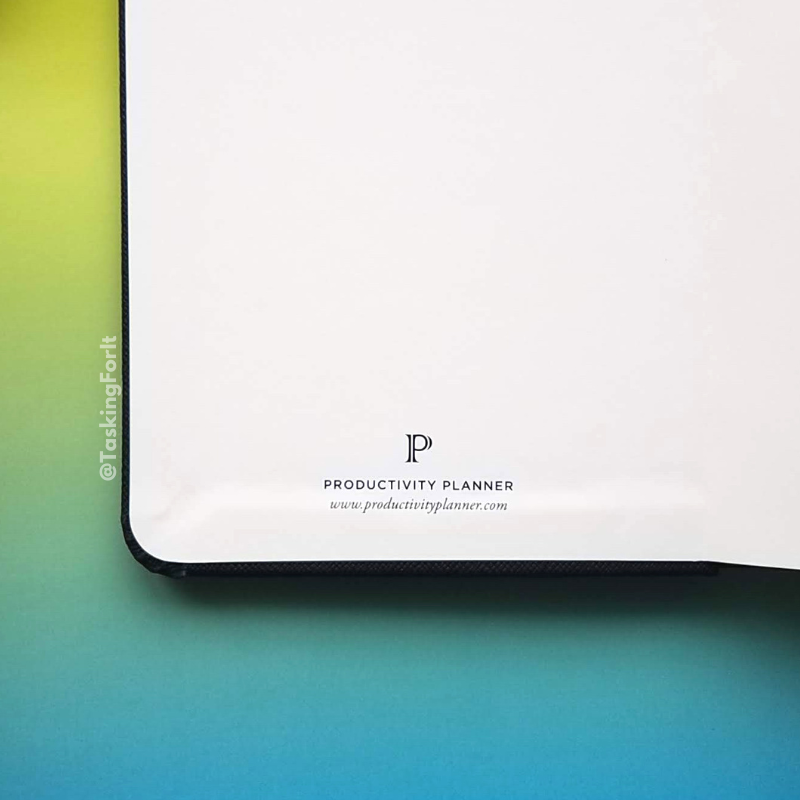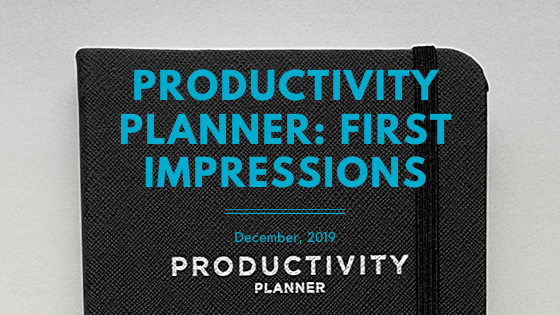In this blog I’ll be giving your my first impressions of the Productivity Planner, and walking through how the planner works.
Review
This review will be for the Productivity Planner. I purchased this planner in November 2019 direct from intelligentchange.com.
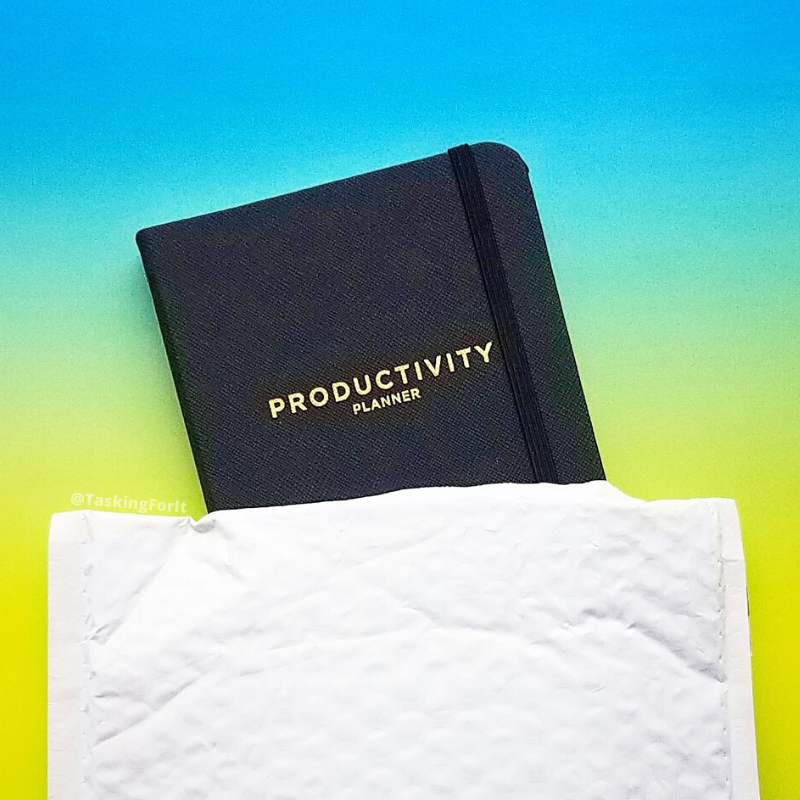
Size:
The Productivity Planner is 5.2 inches wide and 8.5 inches tall. It is 0.8 inches thick with 241 pages. Compared with a classic large Moleskine journal, it’s the same width and slightly taller.
Dating:
This planner is undated, and there are no day-of-week indicators. Each week is made up of the following:
- One weekly planning page
- Five single-day pages
- One two-day page
- One weekly review page
There are 24 weeks included in this planner. If used week-to-week with no gaps, this planner would last just under 6 months.
Aesthetics:

The Productivity Planner is a hardcover, bound notebook. It’s covered in a black, textured, vegan leather with “Productivity Planner” debossed in gold on the front. There is a “P” at the bottom of the front cover, and “Created by Intelligent Change” on the bottom of the back cover; both in gold as well.

I think it’s a professional looking planner. As someone who enjoys a handsome black notebook, this is right up my alley.
Paper:
I could not find the paper weight listed anywhere. However, the Intelligent Change website did indicate that the paper is FSC certified, meaning it comes from forests that are responsibly managed.
Other Features:
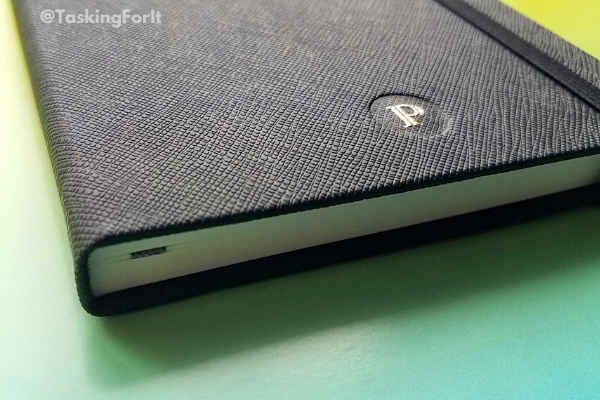
The Productivity Planner has an elastic closure, and one bookmark. There is an “If found…” area printed inside both the front and the back cover. This notebook has no pocket in the back.
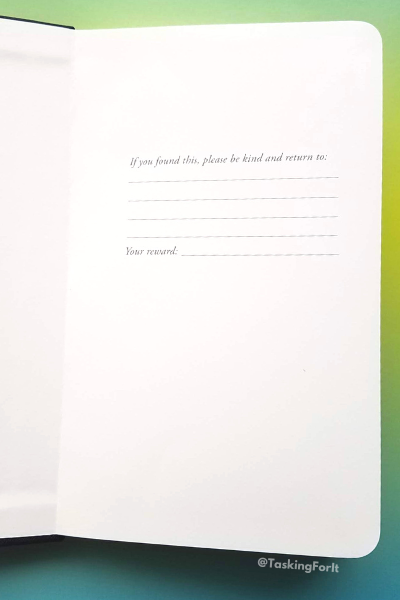
Planning:
The first 41 pages of this planner are dedicated to explaining the methods you will be using in planning out your days and weeks. The first week of planning includes some extra guidance for your planning and review pages. From there, the rest of the notebook is made up of weekly and daily pages, with some motivational quote pages in between some of the weeks.
The Productivity Planner works by asking you to use these core concepts to optimize your productivity each day:
- Prioritize your task list
- Identify your most important task of the day, followed by 2 – 4 other tasks ranked by level of importance. Complete your tasks in order.
- Make sure your tasks are clear and actionable. Break down large tasks into smaller tasks if needed.
- Focus on only 3 – 5 tasks per day
- Be realistic about how much you’re able to do in one day. Keep in mind that “less is more”.
- Be realistic about how much you’re able to do in one day. Keep in mind that “less is more”.
- Use the Pomodoro Technique
- Cut out distractions. Work in un-interrupted sprints of 25 minutes, then take a 5 minute break. Repeat until your task is done.
- Estimate how many Pomodoros you think your task will take, then track how many it actually takes.
- If you’re working on a larger project that requires several hours, write down how many Pomodoros you will dedicate to that task today, and work for that many.
- Review and evaluate
- Rate your level of productivity at the end of each day on a scale of 1 – 10.
- Document your wins and lessons learned at the end of each week. Make a plan for the following week to accomplish anything that was not completed in the prior week.
Price:
The Productivity Planner costs $24.95 on the Intelligent Change website. There are discounts if you order in larger quantities, and individual planners do occasionally go on sale (Black Friday, for example). I would consider this to be a mid-level price point. However, do keep in mind that one planner lasts only 6 months.
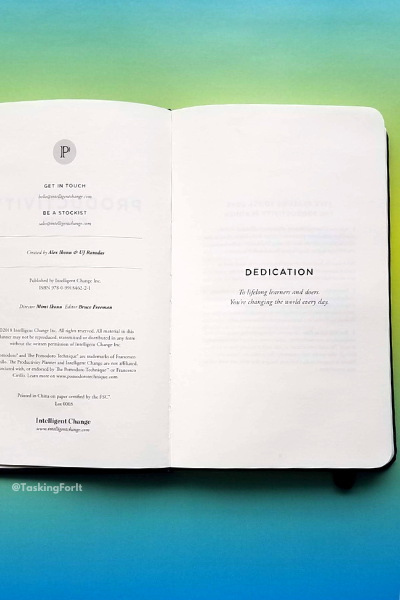
Initial Thoughts:
- The Productivity Planner is clearly designed to be used just for prioritizing and accomplishing daily tasks. There is no future planning, room for events or appointments, or anything like that. That is totally okay, as it is not the goal of this planner. This is just a tool to help you clear away distractions, and get your tasks done.
- The methodology behind this planner will not work for everyone. If your work has a lot of dependencies on others, shifting priorities throughout the day, or the inability to create distraction-free blocks of time, then you’ll struggle with using this system.
- At first glance I’m noticing that the planner is asking you for prioritized, optimized task lists. However, it does not give you much room to formulate those lists. Although I haven’t started using this planner yet, so I can’t know for sure, I’m thinking that I’d need room to hash out what I want my lists to look like before committing them to each weekly and daily page. In order to identify, without question, my most important task of each day, I’m envisioning myself having to do a brain dump of every to-do item that’s on my mind, then sort through and assign priority form there. Each daily page does have a little area for notes where I could maybe try to do this exercise, but it seems like that area is intended to be used throughout your day. Like, for writing down thoughts you have during a Pomodoro, but can’t act on right away. I wish that the beginning of each week had a blank spread to use for coming up with your task lists. Or at least some blank pages in the back of the planner.
- The Pomodoro Technique is one of the pillars of using this system effectively, but they don’t quite explain the entire thing. Most notably, they’ve eliminated any mention of taking a larger break after completing a certain number of pomodoros (usually 4). Maybe they’re assuming that you’ll take a large break after completing each task, but it’s not clear. They only have room for 5 Pomodoros per task, but don’t explicitly say what you should be doing as you transition between tasks. Their instructions about how to use breaks effectively only address your 5-minute break between each Pomodoro. I think it’s a fairly large oversight to omit the value of large breaks in the Pomodoro Technique. Burnout is real, and it’s important to take steps to prevent it.
- I suspect that this planner has gone through some iterations since its initial release. That’s not necessarily a bad thing, but it did lead to some confusion. For example:
- Everything I’ve read online says that there are only 5 daily pages per week. In my planner there are 5 full daily pages, but also another daily page split in half with 2 days on it. So, my planner has 7 days per week. Two of the days (I assume weekends) have just half a page each, and use an abbreviated task list. A lot of the reviews I’ve read of this planner have been asking for 7 daily pages instead of 5, so it could be something that was added in newer versions.
- The online description says there are 23 weeks in this planner, but mine has 24. I’m not sure if maybe they’re not counting the first week, because there is some additional guidance to help you through those pages. So, maybe they’re considering that part of the instructions, and not a real week?
- The page numbers in the table of contents don’t match up to the actual page numbers. My table of contents is off by 2 pages. I’m wondering if there were a few pages removed from the instructions, or if the page numbers in the book simply changed for some reason.
- Everything I’ve read online says that there are only 5 daily pages per week. In my planner there are 5 full daily pages, but also another daily page split in half with 2 days on it. So, my planner has 7 days per week. Two of the days (I assume weekends) have just half a page each, and use an abbreviated task list. A lot of the reviews I’ve read of this planner have been asking for 7 daily pages instead of 5, so it could be something that was added in newer versions.
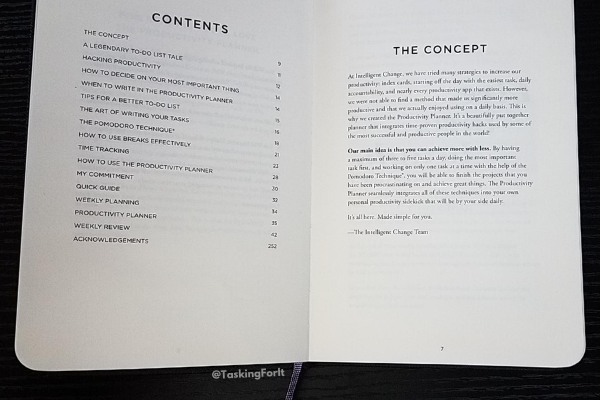
I’m excited to get this planner up and running! I’ll continue to report on what is or isn’t working for me, and hopefully help you out if you’re considering using this planner, too! Follow along with me over on instagram @taskingforit. See you soon!
